Controlling Factors of Productivity in the Fuyu Oil Reservoir of the Lower Cretaceous Songliao Basin, Northeast China
Abstract
1. Introduction
2. Geological Setting

3. Material and Methods
4. Results
4.1. Characteristics of Sedimentary
4.1.1. Characteristics of the Underwater Distributary Channel
4.1.2. Sedimentary Environment
4.1.3. The Vertical Stacking Characteristics of the (Underwater) Distributary Channel
4.2. Two Provenance Systems
4.2.1. Heavy Mineral Assemblage
- Category A Heavy Mineral Assemblage
- Category B Heavy Mineral Assemblage
4.2.2. Maps of Sedimentary Single Factors
4.3. Characteristics of Sedimentary Sand Body
4.4. Reservoir Characteristics
4.4.1. Reservoir Petrological Characteristics
4.4.2. Reservoir Characteristics
5. Discussion
5.1. Impact of Sedimentary and Diagenesis on Reservoir Quality
5.1.1. Sedimentary Environmental Factors
5.1.2. Influence of Diagenesis on Reservoir
- (1)
- Compaction
- (2)
- Cementation
- (3)
- Dissolution
5.2. Advantageous Reservoir
5.2.1. Chang107–Chang104–Chang 52 Well Area
5.2.2. Fu155–Fu161–Fu157 Well Area
5.2.3. Min103–Min31 Well Area
6. Conclusions
Author Contributions
Funding
Data Availability Statement
Acknowledgments
Conflicts of Interest
References
- Merriam, D.E. Symposium on Cyclic Sedimentation. Kans. Kans. Geol. Surv. Bull. 1964, 169, 1–200. [Google Scholar] [CrossRef]
- Wang, Y.; Yan, M.; Lang, Y.; Fu, G.; Li, X. Re-determining source faults of the Upper Cretaceous Putaohua oil layer in Sanzhao sag of Songliao Basin, NE China. Petrol. Explor. Develop. 2015, 42, 802–809. [Google Scholar] [CrossRef]
- Seifert, W.K.; Moldowan, J.M.; Jones, R.W. Application of biological marker chemistry to petroleum exploration. In Proceedings of the Tenth World Petroleum Congress; Heyden & Son, Inc.: Philadelphia, PA, USA, 1980; pp. 425–440. [Google Scholar] [CrossRef]
- Zhao, B.; Wang, C.S.; Wang, X.F. Late Cretaceous (Campanian) Provenance change in the Songliao Basin, NE China: Evidence from detrital zircon U-Pb ages from the Yaojia and Nenjiang Formations. Palaeogeogr. Palaeoclimatol. Palaeoecol. 2013, 385, 83–94. [Google Scholar] [CrossRef]
- Chen, F.; Lu, S.; Liu, H.; Huang, W.; Xu, Y.; Wu, Z. A Discuss on Hydrocarbon Accumulation in Changchunling Anticline Belt, Northern Songliao Basin. Geol. Rev. 2011, 57, 379–386, (In Chinese with English abstract). [Google Scholar] [CrossRef]
- Wang, L. Characteristics of Hydrocarbon Accumulation of Fuyu Reservoir in Chaoyanggou-Changchunling Area. Xinjiang Pet. Geol. 2012, 33, 456–458, (In Chinese with English abstract). [Google Scholar]
- Huang, W.; Wu, H.; Shi, L.; Wang, S.; Wang, Z. Oil and gas source and reservoir characteristic of Fuyu Reservoir of Chaochang area in north Songliao Basin. J. Cent. South Univ. (Sci. Technol.) 2012, 43, 238–248, (In Chinese with English abstract). [Google Scholar]
- Wang, Y. Formation and distributon of the abnormal pressures in 3Chaoyanggou terrace-Changchunling anticlinal belts. Pet. Geol. Oilfield Dev. Daqing 2014, 33, 29–35, (In Chinese with English abstract). [Google Scholar] [CrossRef]
- Shi, L.; Ma, C.; Wang, Z.; Zhang, Y. Oil and gas accumulating conditions and its main controlling factors of Fuyu reservoirs in ChaoChang area. Pet. Geol. Oilfield Dev. Daqing 2014, 33, 1–6, (In Chinese with English abstract). [Google Scholar] [CrossRef]
- Vail, P.R. Stratigraphy Interpretation Using Sequence Stratigraph. Partl: Stratigraphy Interpretation Procedure. AAPG Stud. Seology 1987, 27, 1–10. [Google Scholar]
- Lima, R.D.; De Ros, L.F. The role of depositional setting and diagenesis on the reservoir quality of Late Devonian sandstones from the Solimoes Basin, Brazilian Amazonia. Mar. Pet. Geol. 2002, 19, 1047–1071. [Google Scholar] [CrossRef]
- Zhang, J.L.; Qin, L.J.; Zhang, Z.J. Depositional facies, diagenesis and their impact on the reservoir quality of Silurian sandstones from Tazhong area in central Tarim Basin, western China. J. Asian Earth Sci. 2008, 33, 42–60. [Google Scholar] [CrossRef]
- El-Ghali, M.A.K.; Morad, S.; Mansurbeg, H.; Caja, M.A.; Ajdanlijsky, G.; Ogle, N.; AlAasm, I.; Sirat, M. Distribution of diagenetic alterations within depositional facies and sequence stratigraphic framework of fluvial sandstones: Evidence from the Petrohan Terrigenous Group, Lower Triassic, NW Bulgaria. Mar. Pet. Geol. 2009, 26, 1212–1227. [Google Scholar] [CrossRef]
- Schmid, S.; Worden, R.H.; Fisher, Q.J. Diagenesis and reservoir quality of the Sherwood Sandstone (Triassic), Corrib field, Slyne Basin, west of Ireland. Mar. Pet. Geol. 2004, 21, 299–315. [Google Scholar] [CrossRef]
- Dutton, S.P.; Loucks, R.G. Diagenetic controls on evolution of porosity and permeability in lower Tertiary Wilcox sandstones from shallow to ultradeep (200–6700 m) burial, Gulf of Mexico Basin, U.S.A. Mar. Pet. Geol. 2010, 27, 69–81. [Google Scholar] [CrossRef]
- Morad, S.; Al-Ramadan, K.; Ketzer, J.M.; De Ros, L.F. The impact of diagenesis on the heterogeneity of sandstone reservoirs: A review of the role of depositional facies and sequence stratigraphy. AAPG Bull. 2010, 94, 1267–1309. [Google Scholar] [CrossRef]
- Feng, J.L.; Cao, J.; Hu, K.; Peng, X.Q.; Chen, Y.; Wang, Y.F.; Wang, M. Dissolution and its impacts on reservoir formation in moderately to deeply buried strata of mixed siliciclastic-carbonate sediments, northwestern Qaidam Basin, northwest China. Mar. Pet. Geol. 2013, 39, 124–137. [Google Scholar] [CrossRef]
- Shu, P.; Ding, R.; Qu, Y.; Ji, X. Lithologic and lithofacies patterns of volcanic reservoirs in Xushen Gas Field. Nat. Gas Ind. 2007, 27, 23–28. Available online: https://www.sciengine.com/doi/pdf/7053D59BA0B24EE5847B9450169E8996 (accessed on 10 August 2025).
- Ajdukiewicz, J.M.; Larese, R. How clay grain coats inhibit quartz cement and preserve porosity in deeply buried sandstones: Observations and experiments. AAPG Bull. 2011, 96, 2091–2119. [Google Scholar] [CrossRef]
- Anjos, S.M.C.; DeRos, L.; Silva, C.M.A. Chlorite authigenesis and porosity preservation in the Upper Cretaceous marine sandstones of the Santos Basin, offshore eastern Brazil, Int. Assoc. Sedimentology 2003, 34, 291–316. [Google Scholar] [CrossRef]
- French, M.W.; Worden, R.H.; Mariani, E. Microcrystalline quartz generation and the preservation of porosity in sandstones: Evidence from the Upper Cretaceous of the Subhercynian basin, Germany. J. Sediment. Res. 2012, 82, 422–434. [Google Scholar] [CrossRef]
- Bloch, S.; Lander, R.H.; Bonnell, L. Anomalously high porosity and permeability in deeply buried sandstone reservoirs: Origin and predictability. AAPG Bull. 2002, 86, 301–328. [Google Scholar] [CrossRef]
- Ding, X.; Yang, P.; Han, M.; Chen, Y.; Zhang, S.; Zhang, S.; Liu, X.; Gong, Y.; Nechval, A.M. Characteristics of gas accumulation in a less efficient tight-gas reservoir, He 8 interval, Sulige gas field, Ordos Basin, China. Russ. Geol. Geophys. 2016, 57, 1064–1077. [Google Scholar] [CrossRef]
- Wang, Y.Z.; Shi, S.M. Sedimentary characteristics of Fuyu oil layer in Lingnan block of Changchun. China Manganese Ind. 2018, 36, 94–97. [Google Scholar] [CrossRef]
- Zhu, H.L.; Zhan, S.F.; Liu, X.W.; Xie, Z.R. Study on reservoir characteristics of Lingnan area in Changchun. China Manganese Ind. 2019, 37, 64–67. [Google Scholar] [CrossRef]
- Liu, Z.J.; Wang, D.P.; Liu, L.; Liu, W.S.; Wang, P.J.; Du, X.D.; Yang, G. Sedimentary Characteristics of the Cretaceous Songliao Basin. Acta Geol. Sin. 1993, 6, 167–180. [Google Scholar] [CrossRef]
- Zhang, L.; Wang, Y.M.; Li, S.Q.; Han, J.H.; Zhang, X.T.; Zhu, Y.H.; Wang, G.Y.; Yang, T. High-resolution sequence stratigraphic characteristic and favorable hydrocarbon accumulation prediction of Sifangtai to Mingshui formation in the north of Songliao Basin. J. Cent. South Univ. (Sci. Technol.) 2009, 40, 1679–1688. [Google Scholar] [CrossRef]
- Cheng, R.; Wang, G.; Wang, P.; Gao, Y. Uppermost Cretaceous sediments: Sedimentary microfacies and sedimentary environment evolution of Sifangtai Formation and Mingshui Formation in SKIn. Earth Sci. Front. 2009, 16, 85–95, (In Chinese with English abstract). [Google Scholar] [CrossRef]
- Feng, Z.Q.; Jia, C.Z.; Xie, X.N.; Zhang, S.; Feng, Z.H.; Timothy, A.C. Tectonostratigraphic units and stratigraphic sequences of the nonmarine Songliao Basin, northeast China. Basin Res. 2010, 22, 79–95. [Google Scholar] [CrossRef]
- Zeng, H.; Zhu, X.; Zhu, R.; Zhang, Q. Seismic prediction of sandstone diagenetic facies: Applied to Cretaceous Qingshankou Formation in Qijia Depression, Songliao Basin, East China. Pet. Explor. Dev. 2013, 40, 287–295. [Google Scholar] [CrossRef]
- Li, Z.D.; Wang, D.J.; Zhang, H.X.; Yin, Y.L.; Zhao, F.Q.; Xu, L.; Cheng, P.; Liu, Y. Sedimentary characteristics of typical fluvial facies in the Cretaceous Quantou Formation in southeast uplift of southern Songliao Basin. Oil Gas Geol. 2015, 36, 621–629, (In Chinese with English abstract). [Google Scholar] [CrossRef]
- Zhu, X.; Zeng, H.; Li, S.; Dong, Y.; Zhu, S.; Zhao, D.; Huang, W. Sedimentary characteristics and seismic geomorphologic responses of a shallow-water delta in the Qingshankou Formation from the Songliao Basin, China. Mar. Pet. Geol. 2017, 79, 131–148. [Google Scholar] [CrossRef]
- Donaldson, A.C. Pennsylvanian sedimentation of central Appalachians, special papers. Geol. Soc. Am. 1974, 148, 47–48. [Google Scholar] [CrossRef]
- Wei, W.; Zhang, C.; Zhang, S.; Wu, C.; Yang, K. Study on the Cretaceous turbidite and reservoir features in the Qingshankou Formation in northern Songliao Basin, NE China. Mar. Pet. Geol. 2017, 78, 797–806. [Google Scholar] [CrossRef]
- Chamberlain, C.P.; Wan, X.; Graham, S.A.; Carroll, A.R.; Doebbert, A.C.; Sageman, B.B.; Blisniuk, P.; Kent-Corson, M.L.; Zhou, W.; Wang, C. Stable isotopic evidence for climate and basin evolution of the Late Cretaceous Songliao basin, China. Palaeogeogr. Palaeoclimatol. Palaeoecol. 2013, 385, 106–124. [Google Scholar] [CrossRef]
- Feng, C.; Bao, Z.; Yang, L.; Si, X.; Xu, G.; Han, X. Reservoir architecture and remaining oil distribution of deltaic front underwater distributary channel. Pet. Explor. Dev. 2014, 41, 358–364. [Google Scholar] [CrossRef]
- Pan, S.X.; Wei, P.S.; Wang, T.Q.; Liang, S.J.; Zhao, Z.K.; Zhao, Z.Y.; Tang, Z.X.; Cui, H.N. Discovery of Easter Provenance in Songliao Basic and Its Implications on Petroleum Geology. Nat. Gas Geosci. 2011, 22, 1021–1027, (In Chinese with English abstract). [Google Scholar]
- Sun, Y.; Ma, S.; Cong, L.; Zhao, H.; Yu, L.; Fu, X. Study on Depositional Characteristics and Model of Fuyu Oil Layer in the Southern Fuxin Uplift of Songliao Basin. Acta Sedimentol. Sin. 2012, 30, 706–715, (In Chinese with English abstract). [Google Scholar] [CrossRef]
- Feng, C.; Bao, Z.; Dai, C.; Zhang, Z. Superimposition patterns of underwater distributary channel sands in deltaic front and its control on remaining oil distribution: A case study from K1q4 in J19 block, Fuyu oilfield. Oil Gas Geol. 2015, 36, 128–135, (In Chinese with English abstract). [Google Scholar] [CrossRef]
- Horne, J.C.; Ferm, J.C.; Caruccio, F.T.; Baganz, B.P. Depositional models in coal exploration and mine planning in appalachian region. AAPG Bull. 1976, 62, 2379–2411. [Google Scholar] [CrossRef]
- Zhu, X.M.; Liu, Y.; Fang, Q.; Li, Y.; Liu, Y.Y.; Wang, R.; Song, J.; Liu, S.Q.; Cao, H.T.; Liu, X.N. Formation and sedimentary model of shallow delta in largescale lake.example from cretaceous Quantou Formation in Sanzhao Sag, Songliao Basin. Earth Sci. Front. 2012, 19, 89–99, (In Chinese with English abstract). [Google Scholar]
- Lefebvre, C.; Barnhoorn, A.; van Hinsbergen, D.J.J.; Kaymakci, N.; Vissers, R.L.M. Late Cretaceous extensional denudation along a marble detachment fault zone in the Kirşehir massif near Kaman, central Turkey. J. Struct. Geol. 2011, 33, 1220–1236. [Google Scholar] [CrossRef]
- Xi, K.; Cao, Y.; Jahren, J.; Zhu, R.; Bjørlykke, K.; Girma Haile, B.; Zheng, L.; Hellevang, H. Diagenesis and reservoir quality of the Lower Cretaceous Quantou Formation tight sandstones in the southern Songliao Basin, China. Sediment. Geol. 2015, 330, 90–107. [Google Scholar] [CrossRef]
- Engebretson, D.C.; Cox, A.; Gordan, R.G. Relative motions between oceanic and continental. Soc. Am. Spec. Pap. 1985, 206, 1–60. [Google Scholar] [CrossRef]
- Maruyama, S.; Tetsuzo, S. Orogeny and relative plate motions; example of the Japanese islands. Tectonophysics 1986, 127, 305–329. [Google Scholar] [CrossRef]
- Li, D.; Dong, C.; Lin, C.; Ren, L.; Jiang, T.; Tang, Z. Control factors on tight sandstone reservoirs below source rocks in the Rangzijing slope zone of southern Songliao Basin, East China. Pet. Explor. Dev. 2013, 40, 742–750. [Google Scholar] [CrossRef]
- Houseknecht, D.W. Assessing the relative importance of compaction processes and cementation to reduction of porosity in sandstones. AAPG Bull. 1987, 71, 633–642. [Google Scholar] [CrossRef]
- Wimmers, K.; Koehrer, B. Integration of sedimentology, petrophysics and rock typing as key to understanding a tight gas reservoir. Oil Gas Eur. Mag. 2014, 40, 196–200. [Google Scholar]
- Vytyaz, O.; Chernova, O.; Stavychnyi, Y.; Martyniuk, R.; Ziaja, J. Increasing the reliability of oil and gas well fastening with polycomponent plugging systems. Min. Miner. Depos. 2024, 18, 82–93. [Google Scholar] [CrossRef]
- Schmidt, V.; Mc Donald, D.A. The role of secondary porosity in the course of sandstone diagenesis. SEPM Spec. Publ. 1979, 26, 175–207. [Google Scholar] [CrossRef]
- Mahmoud, H. Automatic characterization and quantitative analysis of seismic facies in naturally fractured reservoir: Case study of Amguid Messaoud field, Algeria. Min. Miner. Depos. 2023, 17, 42–48. [Google Scholar] [CrossRef]
- Dzhangirov, A.N.; Bekbaltina, G.K.; Umirova, G.K.; Temirkhanova, R.G.; Abdoldina, F.N. Comparative analyzing the technology of predicting reservoir properties according to seismic data based on linear and nonlinear prediction algorithms. Eng. J. Satbayev Univ. 2024, 146, 54–60. [Google Scholar] [CrossRef]
- Faerseth, R.B. Interaction of Permo-Triassic and Jurassic extensional fault-blocks during the development of the northern North Sea. J. Geol. Soc. Lond. 1996, 153, 931–944. [Google Scholar] [CrossRef]

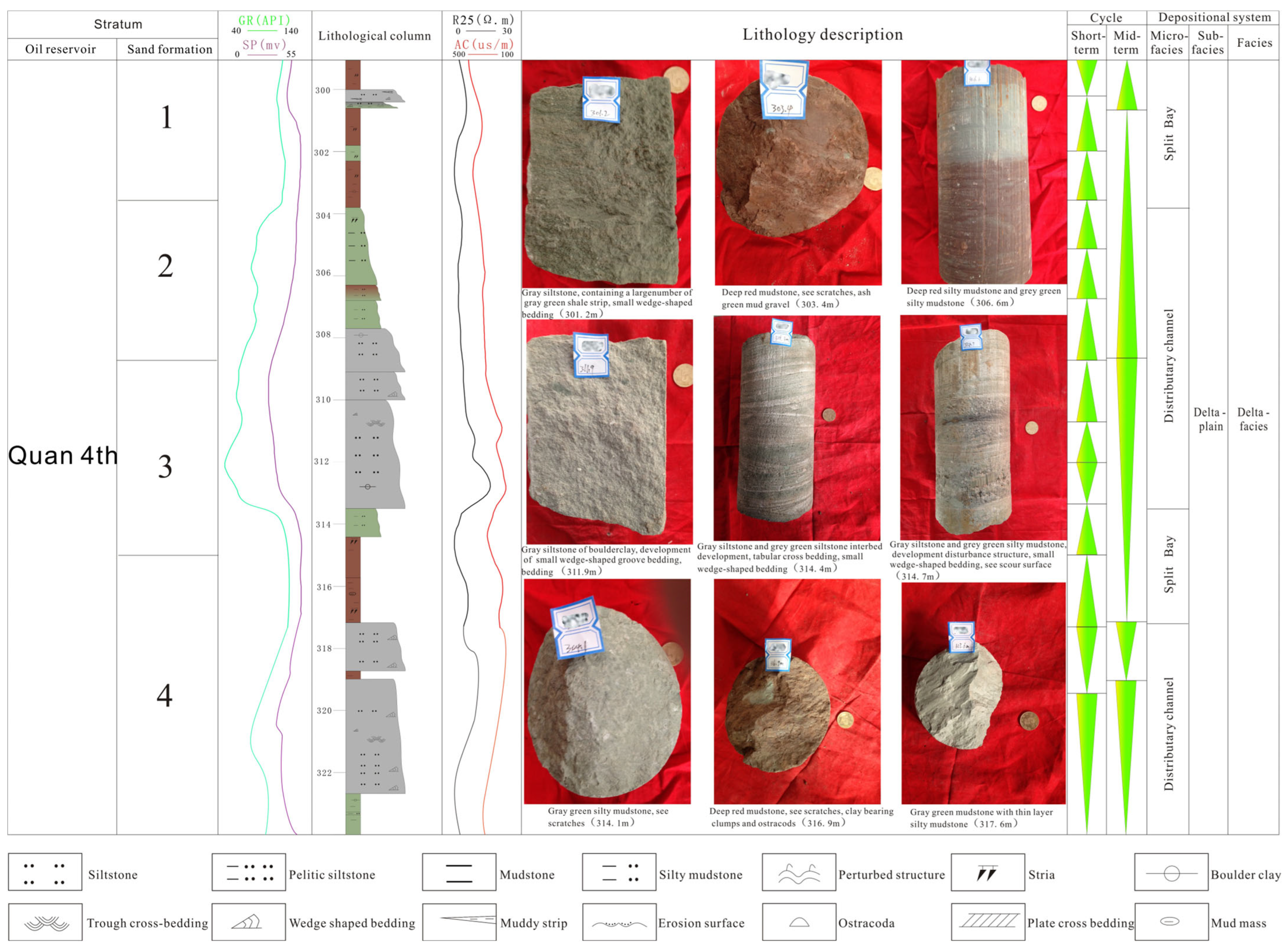
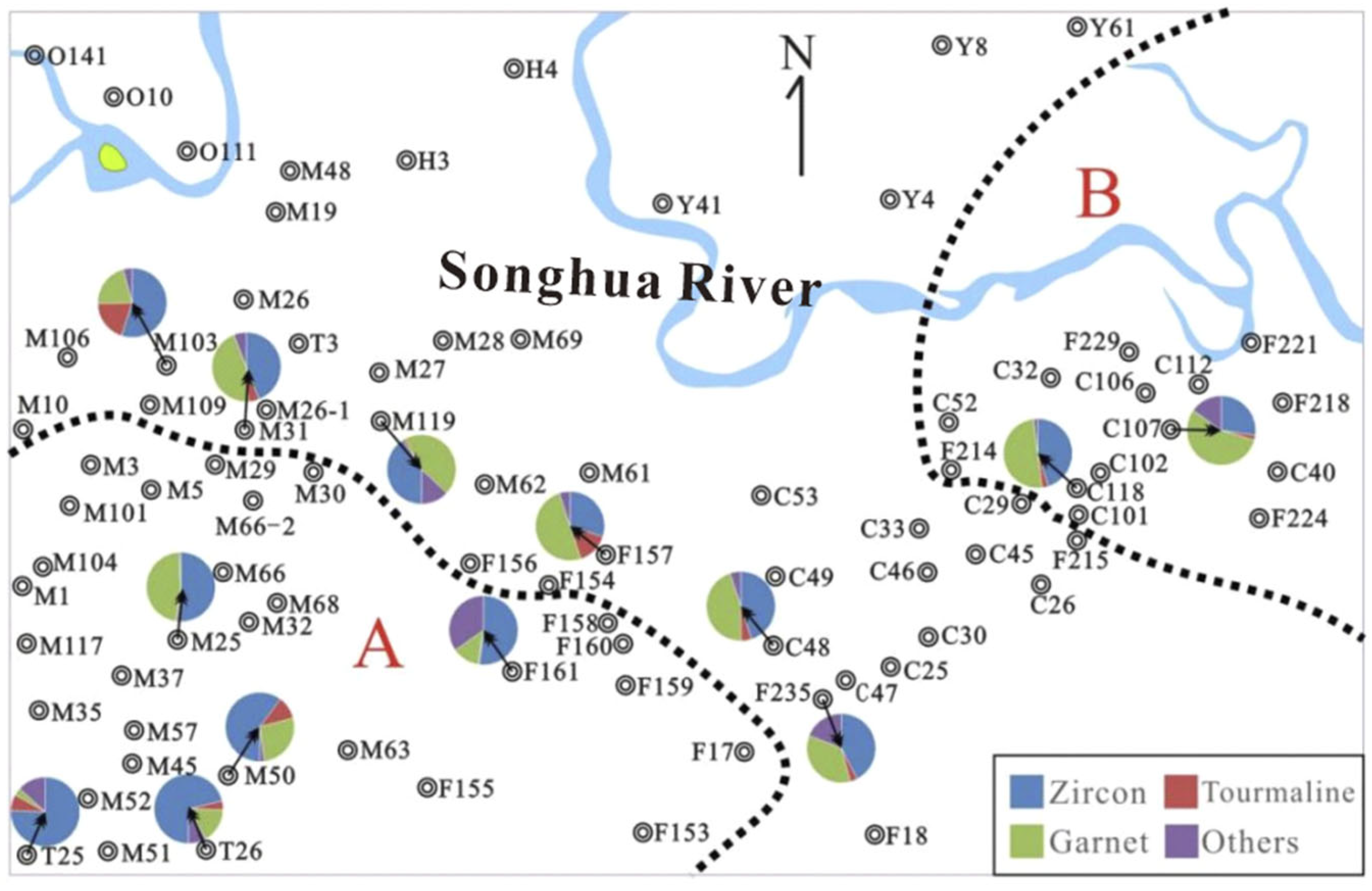

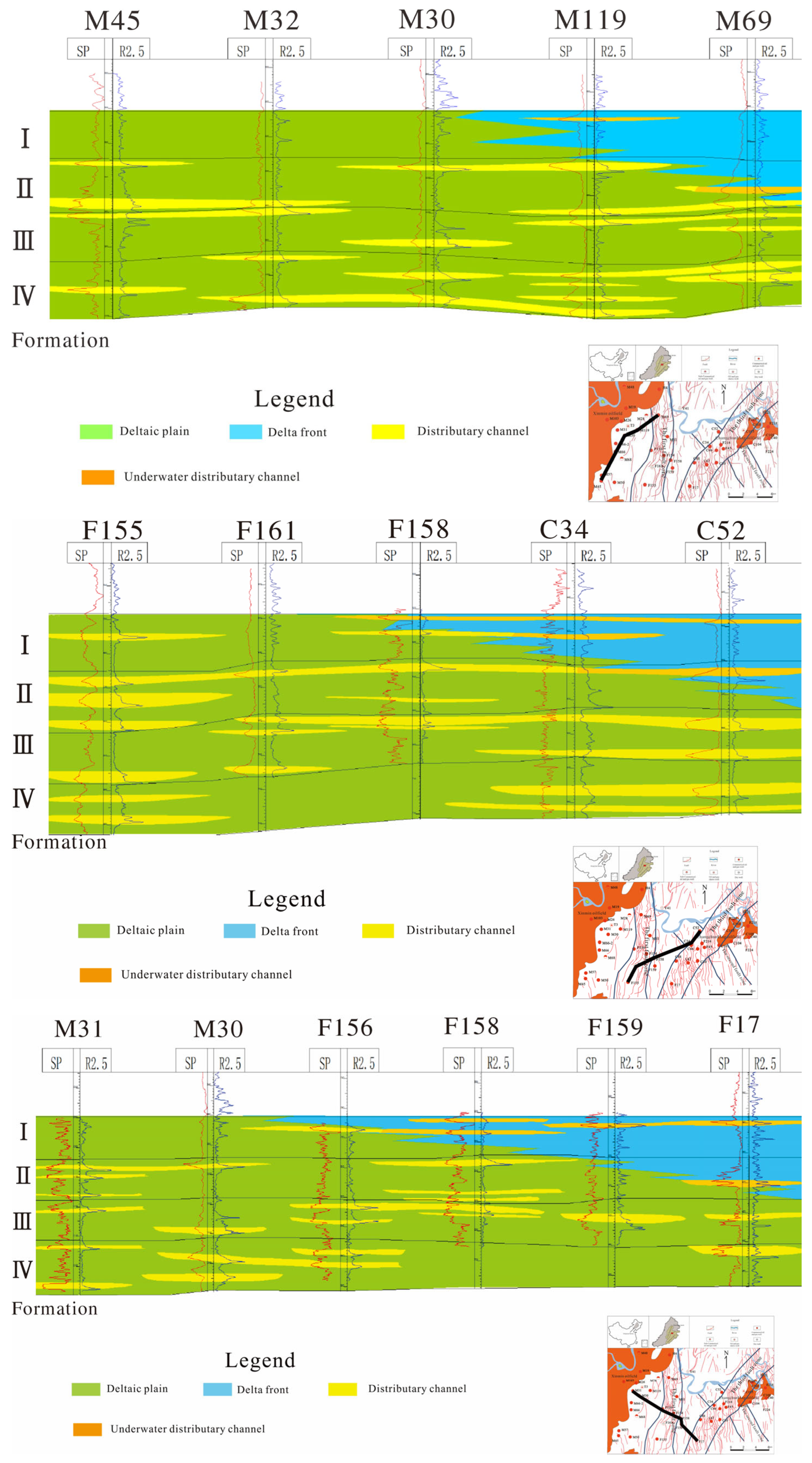
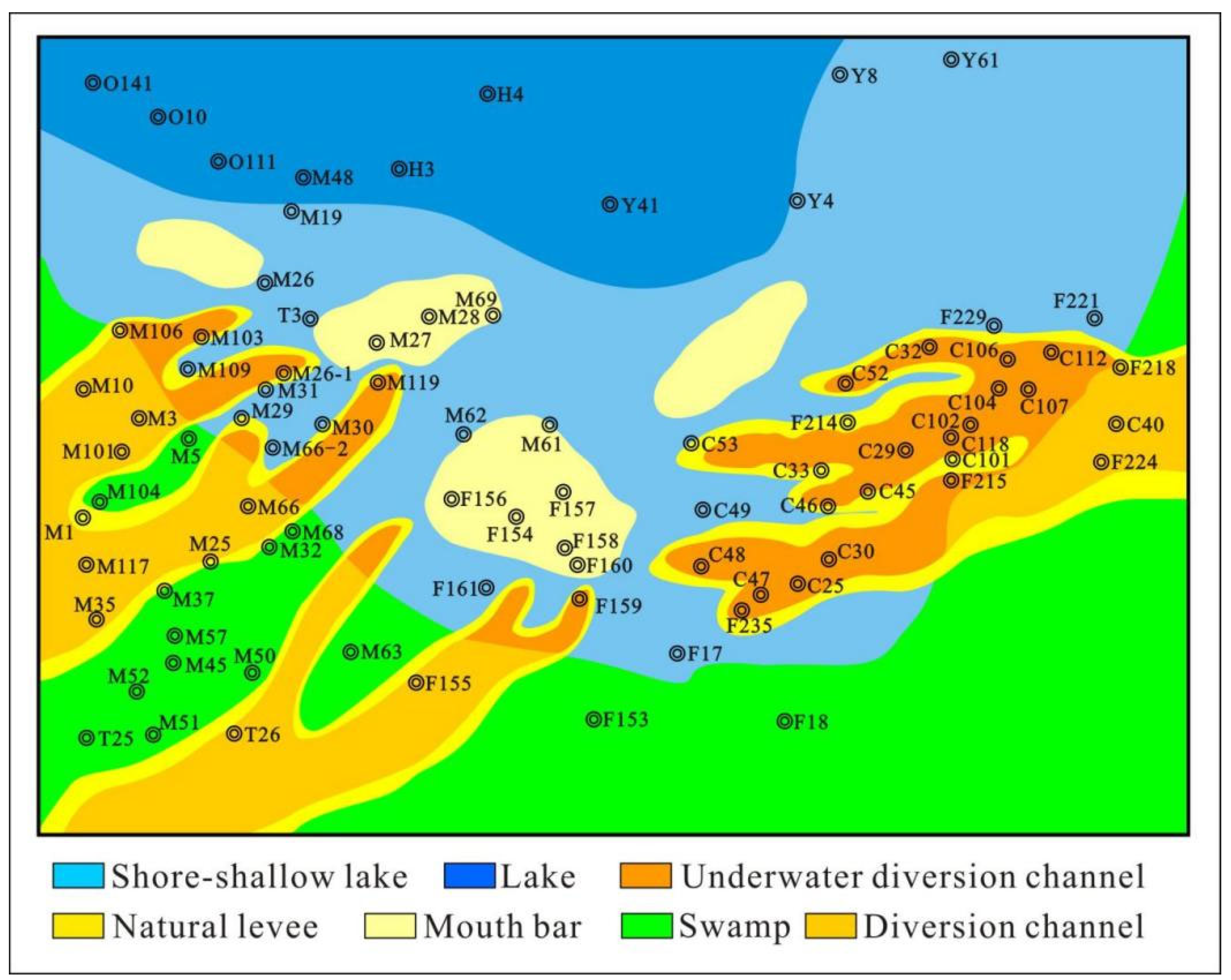
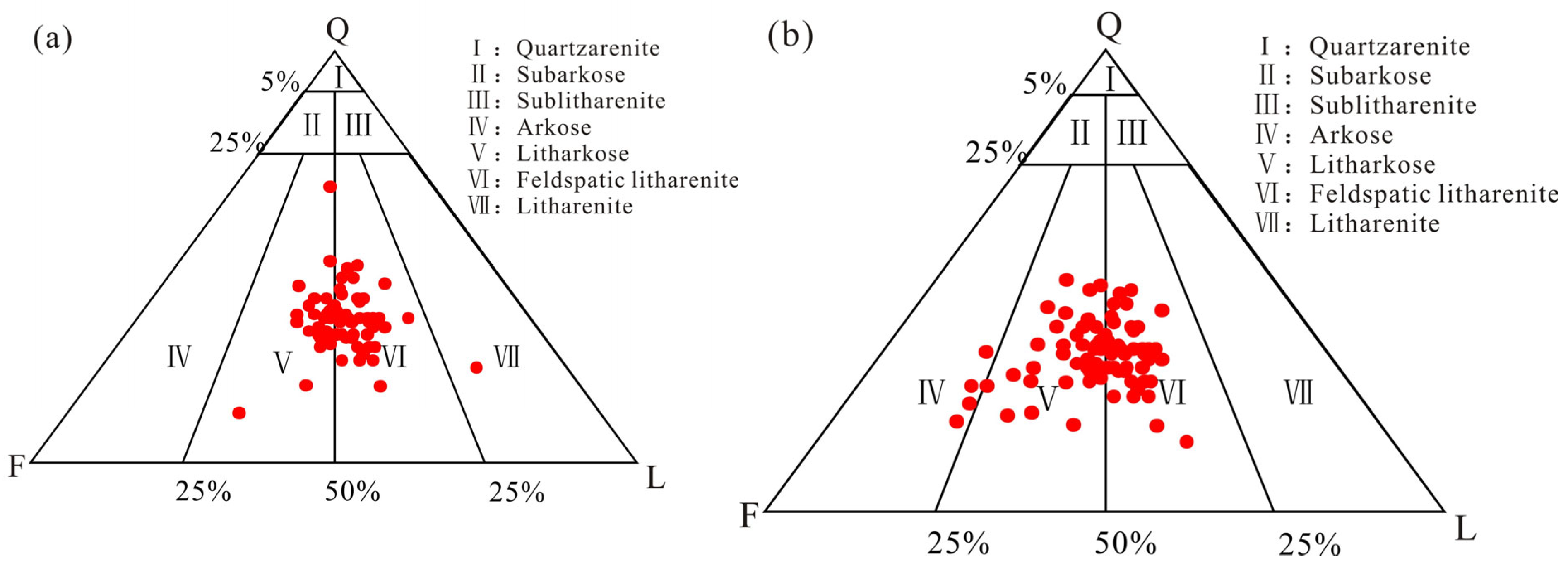
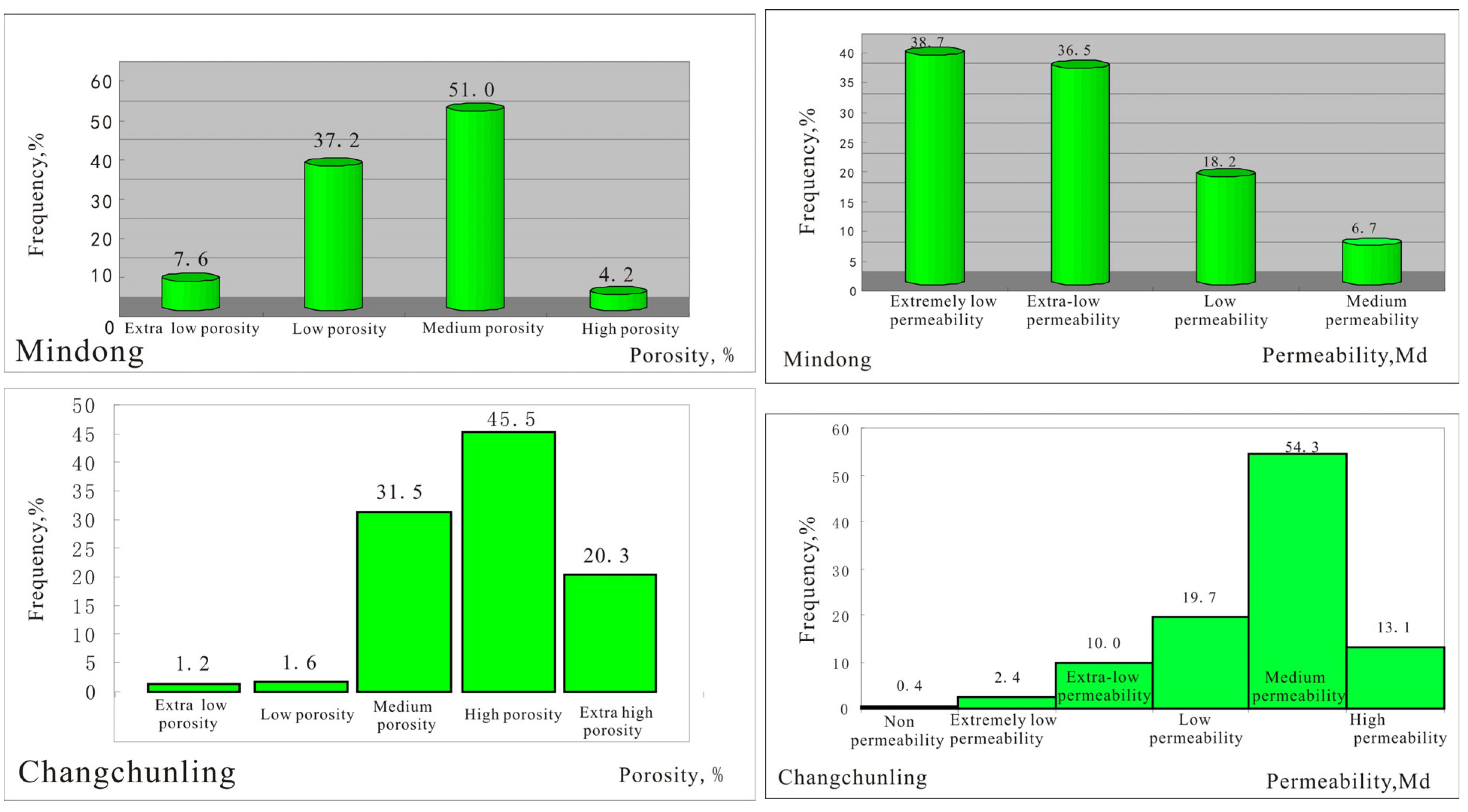
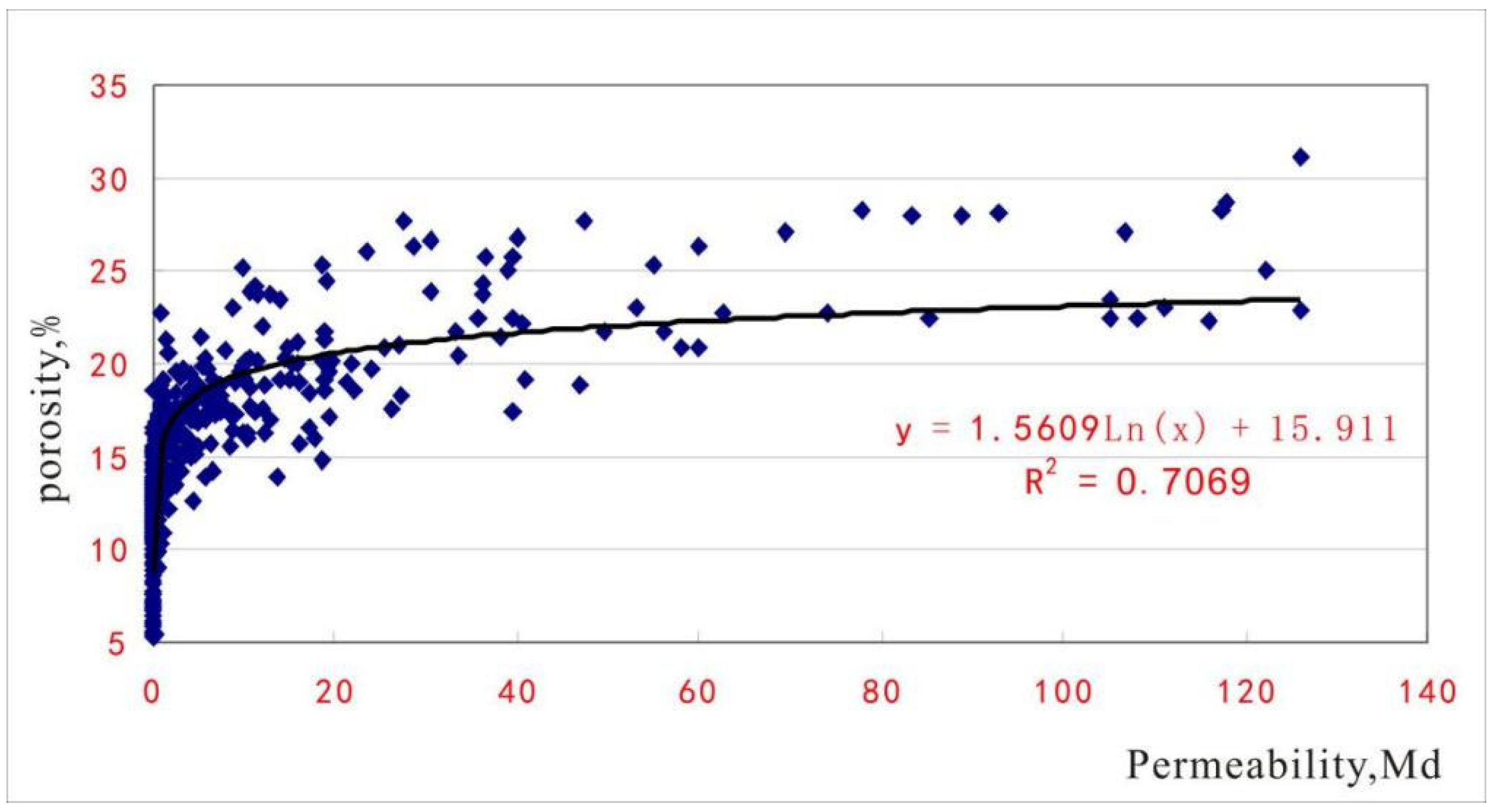

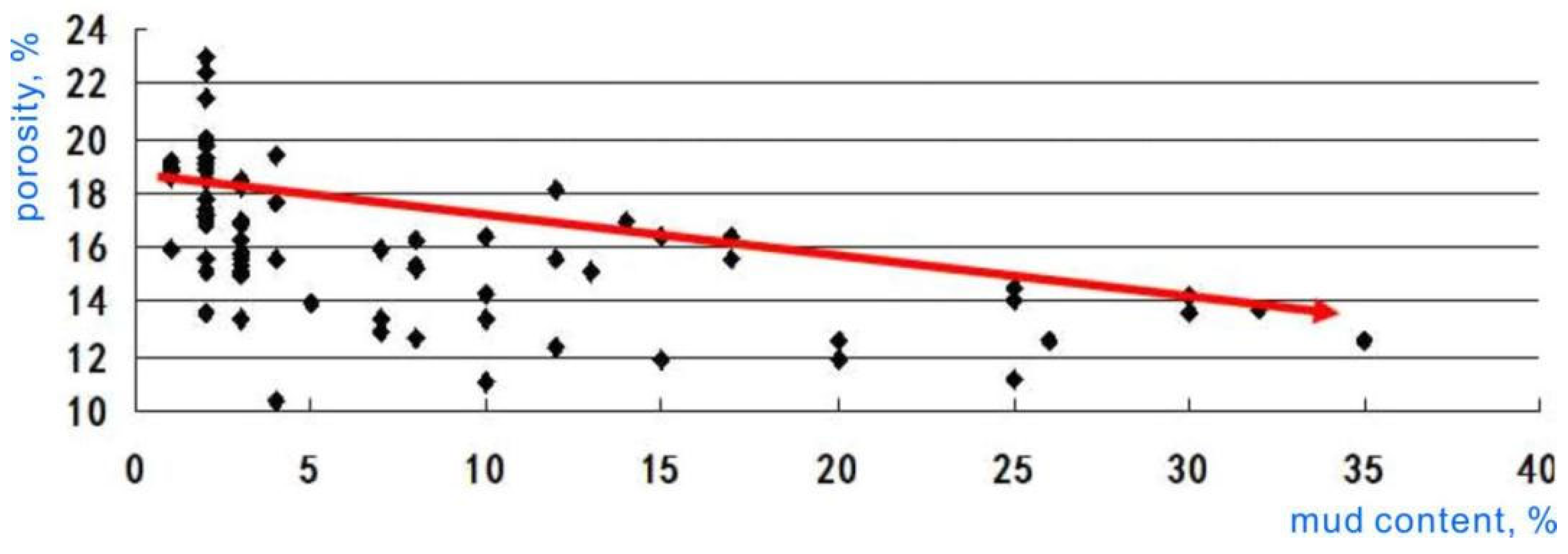

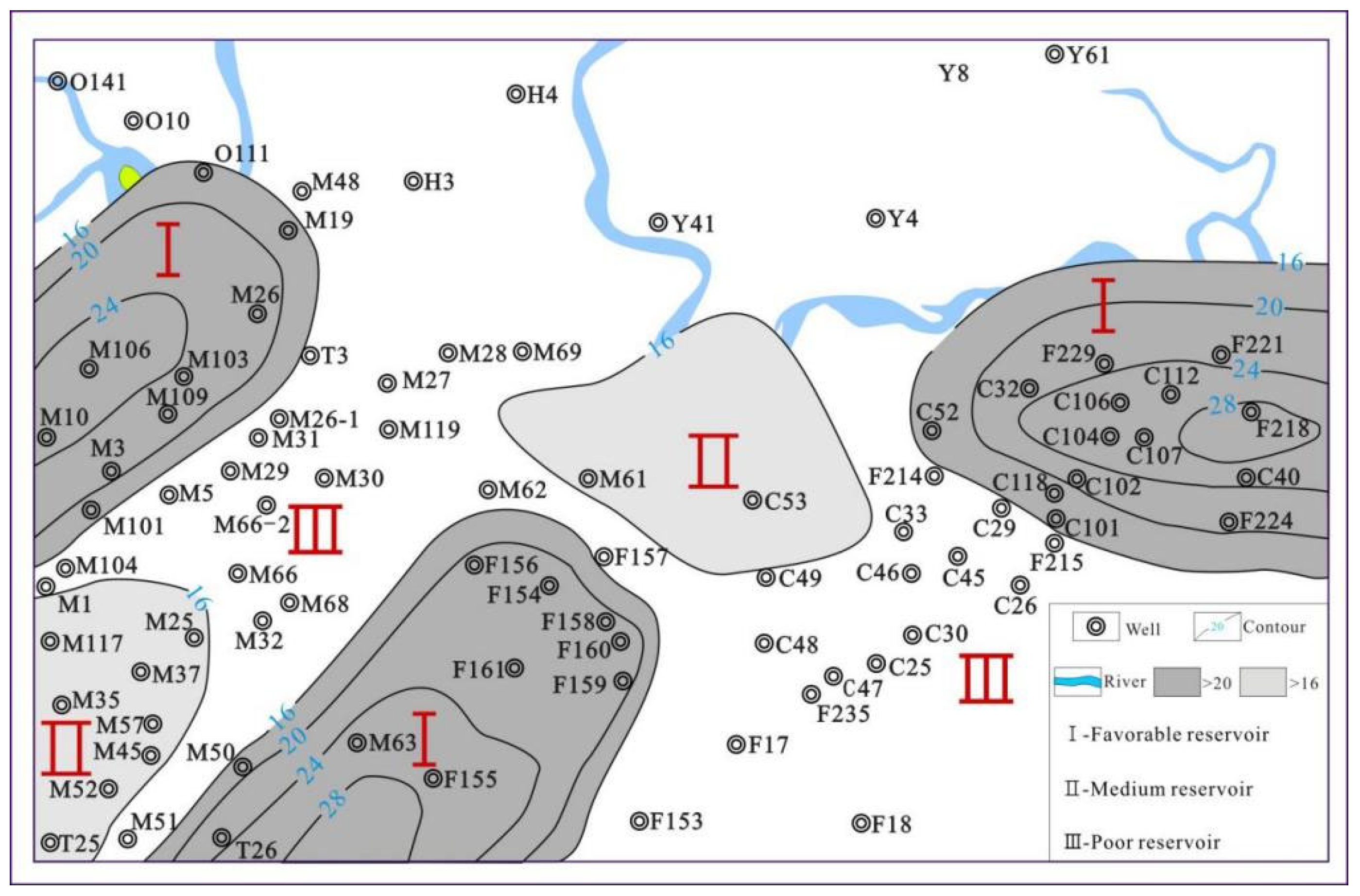
| Number of Well | M19 | M69 | M103 | M26 | M29 | M68 | M117 | M25 | M1 |
|---|---|---|---|---|---|---|---|---|---|
| Oil production t/d | 17.10 | 0.80 | 0.40 | 17.40 | 0.50 | 0.10 | 0.90 | 1.80 | 0.10 |
| Porosity (%) | 20.21 | 4.80 | 9.10 | 19.70 | 13.30 | 5.20 | 11.60 | 16.30 | 7.20 |
| Permeability (×10−3 µm2) | 18.60 | 0.10 | 0.24 | 23.90 | 0.28 | 0.49 | 0.08 | 1.20 | 0.03 |
| Number of well | M37 | M35 | M51 | C110 | C106 | C112 | C113 | C114 | H3 |
| Oil production t/d | 8.20 | 16.90 | 0.10 | 13.30 | 6.30 | 2.70 | 0.30 | 0.10 | 2.10 |
| Porosity (%) | 18.80 | 13.90 | 0.06 | 33.50 | 21.01 | 12.60 | 15.30 | 13.20 | 19.70 |
| Permeability (×10−3 µm2) | 5.20 | 10.60 | 5.30 | 165.10 | 16.97 | 2.31 | 0.65 | 0.27 | 6.10 |
| Number of well | C107 | C104 | C102 | C101 | F154 | F158 | T25 | T26 | H4 |
| Oil production t/d | 8.20 | 0.90 | 1.40 | 6.30 | 6.60 | 6.60 | 0.10 | 0.40 | 1.90 |
| Porosity (%) | 26.40 | 20.30 | 21.70 | 30.80 | 20.90 | 22.20 | 8.20 | 9.70 | 18.40 |
| Permeability (×10−3 µm2) | 96.20 | 2.94 | 4.45 | 88.81 | 59.90 | 40.60 | 0.02 | 0.08 | 2.50 |
| Well Name | Location | Sample No. | Depth (m) | Detrital Component/% | Cements (%) | Porosity (%) | Permeability (Md) | ||||||||
|---|---|---|---|---|---|---|---|---|---|---|---|---|---|---|---|
| Quartz | Feldspar | Rock Fragments | Carbonate | Mud | Grey | Quartz Increase | |||||||||
| Potash | Plagioclase | Igneous | Metamorphic | Sedimentary | |||||||||||
| M19 | Mindong | S3 | 1171.16 | 31 | 16 | 15 | 31 | 3 | 4 | 6 | 2 | 0 | 0 | 19 | 8.9 |
| M19 | Mindong | S18 | 1176.05 | 36 | 16 | 17 | 25 | 3 | 3 | 3.4 | 1 | 2 | 0 | 19.1 | 14 |
| M19 | Mindong | S20 | 1178.13 | 36 | 18 | 20 | 18 | 3 | 5 | 7.9 | 8 | 11 | 1 | 12.7 | 0.81 |
| M103 | Mindong | S1 | 749.68 | 37 | 15 | 16 | 24 | 2 | 5 | 1.4 | 0 | 27 | 0 | 22.8 | 0.82 |
| M26 | Mindong | S7 | 1129.65 | 29 | 15 | 20 | 30 | 2 | 0 | 0.9 | 3 | 0 | 2 | 18.5 | 0.13 |
| M26 | Mindong | S26 | 1135.13 | 38 | 8 | 23 | 25 | 2 | 0 | 2.2 | 3 | 1 | 2 | 16.3 | 0.85 |
| M26 | Mindong | S34 | 1143.07 | 37 | 12 | 19 | 25 | 2 | 0 | 10.7 | 4 | 1 | 0 | 10.4 | 0.17 |
| M117 | Mindong | 3 | 1089.93 | 32 | 18 | 20 | 2 | 0 | 0 | 15 | 1 | 0 | 2 | 9.3 | 0.2 |
| M35 | Mindong | 20 | 1062.71 | 30 | 12 | 15 | 37 | 3 | 3 | 0 | 0 | 0 | 2 | 17.3 | 0.99 |
| M35 | Mindong | S17 | 1063.67 | 30 | 15 | 15 | 30 | 2 | 8 | 0 | 0 | 0 | 3 | 18.2 | 3.8 |
| M57 | Mindong | 6 | 989.26 | 35 | 14 | 13 | 35 | 3 | 0 | 0.2 | 2 | 1 | 3 | 17.8 | 0.81 |
| M57 | Mindong | 8 | 989.86 | 35 | 15 | 13 | 30 | 5 | 2 | 4.4 | 0 | 4 | 3 | 16.2 | 9.81 |
| M51 | Mindong | 30 | 899.46 | 49 | 26 | 0 | 0 | 0 | 25 | 16.4 | 0 | 32 | 0 | 10.9 | 0.03 |
| F161 | Mindong | 25 | 649.65 | 30 | 14 | 18 | 38 | 0 | 0 | 1.5 | 2 | 1 | 0 | 21.5 | 38 |
| F235 | Changchunling | 11 | 308.85 | 36 | 22 | 16 | 24 | 2 | 0 | 2.9 | 0 | 0 | 0 | 28.1 | 92.81 |
| F235 | Changchunling | 31 | 311.85 | 30 | 23 | 10 | 35 | 2 | 0 | 5.4 | 2 | 1 | 0 | 25 | 38.97 |
| F223 | Changchunling | s2 | 238.98 | 38 | 20 | 1 | 41 | 0 | 0 | 4.8 | 18 | 3 | 2 | 27.4 | 50.4 |
| F223 | Changchunling | 6 | 269.96 | 30 | 24 | 2 | 44 | 0 | 0 | 2.9 | 15 | 0 | 2 | 25.1 | 27.3 |
| F223 | Changchunling | s10 | 275.56 | 32 | 25 | 3 | 40 | 0 | 0 | 1.7 | 21 | 1 | 0 | 25.2 | 29.5 |
| F223 | Changchunling | s20 | 280.31 | 32 | 25 | 2 | 42 | 0 | 0 | 4.7 | 27 | 2 | 1 | 25.8 | 0 |
| F223 | Changchunling | s23 | 287.46 | 31 | 24 | 1 | 45 | 0 | 0 | 9.7 | 5 | 0 | 2 | 22.2 | 80.6 |
| F223 | Changchunling | s30 | 292.74 | 31 | 22 | 3 | 43 | 0 | 0 | 3.6 | 5 | 1 | 2 | 24.2 | 57.8 |
| F215 | Changchunling | 10 | 310.34 | 29 | 24 | 2 | 0 | 0 | 0 | 5.1 | 27 | 1 | 0 | 24.7 | 52.2 |
| F215 | Changchunling | 18 | 333.84 | 29 | 23 | 3 | 0 | 0 | 0 | 0.1 | 13 | 1 | 0 | 27.8 | 135.3 |
| F215 | Changchunling | 22 | 337.93 | 26 | 23 | 3 | 0 | 0 | 0 | 0.4 | 12 | 1 | 0 | 28.8 | 332.3 |
| F215 | Changchunling | 25 | 339.86 | 27 | 24 | 2 | 0 | 0 | 0 | 2.1 | 13 | 2 | 0 | 27.4 | 152.1 |
| C107 | Changchunling | 6 | 188.97 | 28 | 23 | 12 | 31 | 3 | 3 | 0.31 | 2 | 1 | 0 | 29.1 | 500.26 |
| C107 | Changchunling | 11 | 212.87 | 28 | 23 | 12 | 32 | 2 | 4 | 1.88 | 3 | 1 | 0 | 28.6 | 507.21 |
| C107 | Changchunling | 18 | 216.47 | 26 | 24 | 12 | 33 | 3 | 2 | 1.88 | 2 | 1 | 0 | 30.8 | 871.19 |
| C107 | Changchunling | 21 | 218.27 | 26 | 24 | 12 | 33 | 3 | 2 | 3.13 | 2 | 1 | 0 | 33.2 | 507.21 |
| C107 | Changchunling | 23 | 220.17 | 26 | 24 | 12 | 33 | 3 | 2 | 4.85 | 2 | 3 | 0 | 25.2 | 203.95 |
| C107 | Changchunling | s27 | 223.32 | 26 | 24 | 12 | 33 | 3 | 2 | 3.44 | 2 | 3 | 0 | 25.1 | 290.68 |
| Mindong/Changchunling Physical Property | Distributary Channel | (Underwater) Distributary Channel | Split Bay | Sheet Sand | Mouth Bar |
|---|---|---|---|---|---|
| Mindong porosity (%) | 20–30 | 16–25 | 10–18 | 12–20 | 14–22 |
| Mindong permeability (Md) | 60–100 | 20–120 | 0.1–1 | 0.5–2 | 2–10 |
| Changchunling porosity (%) | 22–32 | 18–30 | 12–25 | 12–20 | 14–22 |
| Changchunling permeability (Md) | 80–120 | 40–140 | 0.1–1 | 0.5–2 | 2–10 |
Disclaimer/Publisher’s Note: The statements, opinions and data contained in all publications are solely those of the individual author(s) and contributor(s) and not of MDPI and/or the editor(s). MDPI and/or the editor(s) disclaim responsibility for any injury to people or property resulting from any ideas, methods, instructions or products referred to in the content. |
© 2025 by the authors. Licensee MDPI, Basel, Switzerland. This article is an open access article distributed under the terms and conditions of the Creative Commons Attribution (CC BY) license (https://creativecommons.org/licenses/by/4.0/).
Share and Cite
Li, W.; Liao, Z.; Lai, P.; Tian, J.; Du, S. Controlling Factors of Productivity in the Fuyu Oil Reservoir of the Lower Cretaceous Songliao Basin, Northeast China. Processes 2025, 13, 2623. https://doi.org/10.3390/pr13082623
Li W, Liao Z, Lai P, Tian J, Du S. Controlling Factors of Productivity in the Fuyu Oil Reservoir of the Lower Cretaceous Songliao Basin, Northeast China. Processes. 2025; 13(8):2623. https://doi.org/10.3390/pr13082623
Chicago/Turabian StyleLi, Wenjie, Zhengkai Liao, Peng Lai, Jijun Tian, and Shitao Du. 2025. "Controlling Factors of Productivity in the Fuyu Oil Reservoir of the Lower Cretaceous Songliao Basin, Northeast China" Processes 13, no. 8: 2623. https://doi.org/10.3390/pr13082623
APA StyleLi, W., Liao, Z., Lai, P., Tian, J., & Du, S. (2025). Controlling Factors of Productivity in the Fuyu Oil Reservoir of the Lower Cretaceous Songliao Basin, Northeast China. Processes, 13(8), 2623. https://doi.org/10.3390/pr13082623








